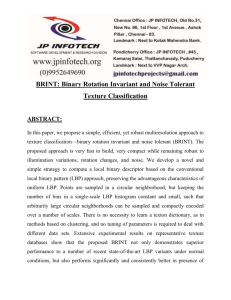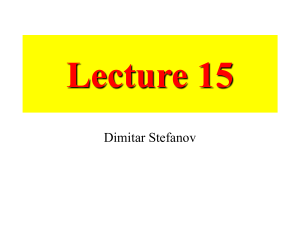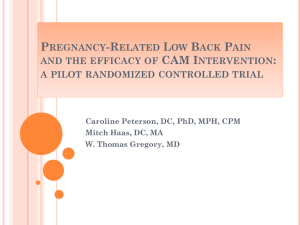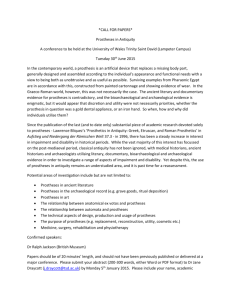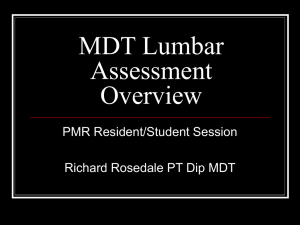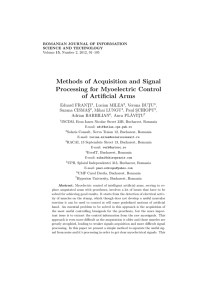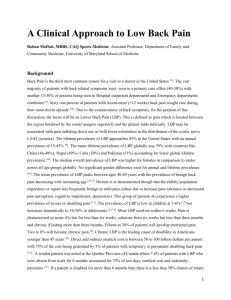Seminar 2013 McCool - University of Strathclyde
advertisement
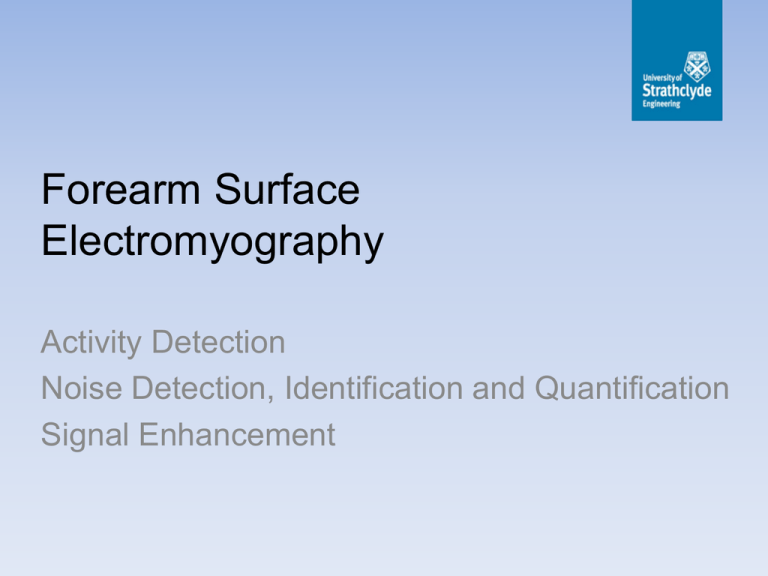
Forearm Surface Electromyography Activity Detection Noise Detection, Identification and Quantification Signal Enhancement Aim of research • Make myoelectric forearm prostheses more useable • So far – Onset detection – Noise reduction Today • Introduction to myoelectric signals, prostheses and control • Onset and activity detection • Carleton University’s CleanEMG - Noise detection, identification, quantification • Signal enhancement Myoelectric signals and prostheses Forearm Prosthesis Control • None (passive) – Realistic looking – Has a few basic uses • Body powered – User shrugs to open and close claw – Proprioception – Limited orientation • Myoelectric – Pick up muscle signals and interpret them into open and close commands – Mostly claw/pincer-type – First commercial limb in 1964 What myoelectric prostheses are not • No sensory feedback – No proprioception – One gesture at a time • Not as dextrous as natural hands - No direct control of fingers • • • Not part of your body Doff every night to charge Takes a while to don the socket every morning The iLimb State-of-the-Art Forearm Prostheses • Made by Touch Bionics in Livingston • Individually articulated fingers • Motors stall when ‘enough’ grip has been applied – Monitored by microprocessor • Clever re-use of open/close to allow more gestures • Can ‘pulse’ the motors to increase grip The iLimb and iLimb Digits Limitations of myoelectric prostheses • iLimb shares limitations with all modern commercial myoelectric prostheses: – Amplitude-based commands do not directly relate to desired gesture • Not all users can do all ‘double impulse’-type commands – Cannot address individual fingers – Manual thumb rotation for pinch and grip – Limited battery life – a day of normal use The Myoelectric Signal Examples of typical sEMG signal Generic Pattern Recognition System Multi-channel raw sEMG signal (live or recorded) Sample Filter Onset/activity detection Windowing Majority vote Classifier Dimensionality reduction Feature extraction Class label stream One-Dimensional Local Binary Patterns for Surface EMG Activity Detection 2-D Local Binary Patterns • For image analysis • Spatiotemporal LBP for video analysis http://www.scholarpedia.org/article/File:LBP.jpg One-Dimensional (1-D) Local Binary Patterns • Take windows of signal • Calculate LBP codes within window • Form normalised histogram x[n] n 0 0 1 20 21 22 Sample number 1 0 0 23 24 25 = 12 in decimal 1-D LBP Activity Detection x[n] 𝑤 𝑗 𝑥[𝑛] LBP code calculation 1-D LBP histogram calculation ‘Inactivity’ bins No activity NO ‘Activity’ bins Activity bins> Inactivity bins YES Activity 1-D LBP Bin Behaviour • Test on a synthetic signal (bandlimited Gaussian noise with AWGN 6dB) 𝐻𝐵−1 𝐻2 𝑃 2 −1 1-D LBP bin behaviour • Test on single gesture of real EMG recording 𝐻𝐵−1 𝐻2 𝑃 2 −1 1-D LBP Activity Detection • Once activity is detected, pattern recognition can be started • Can sum the LBP codes from multiple channels within a window to get a single decision Placement at Carleton University, Ottawa, Canada CleanEMG Carleton University’s CleanEMG • Access to an expert to manually identify and/or mitigate noise is not always possible • EMG can be contaminated with several types of noise • For each type, do some or all of these: – – – – Detect Identify Quantify Mitigate Types of EMG noise • Power line (50Hz or 60Hz) • ECG • Clipping • Quantisation • Amplifier saturation Also • Baseline wander • RF Features • • • • • Signal to Quantisation Noise Ratio Signal to ECG Ratio Effective Number of Bits Signal to Motion Artefact Ratio Power line Power (Least Squares Identification) SQNR SNR (ECG) ENOB SMR 𝑃60𝐻𝑧 Why a classifier? • Contaminants can be mistaken for each other if a single feature type is used – Motion artefact and ECG – Clipping and quantisation • Training a classifier should help to address this Work done at Carleton • Improved Prof Chan’s and Graham Fraser’s CleanEMG Matlab code • Trained classifiers to identify contaminants using artificially-contaminated real and synthetic EMG – Indicated that detection and identification are harder for signals with higher SNR Classification accuracy • The techniques lead to improvements in classification accuracy for noisy data – Data Set 1 (Recorded at Strathclyde) – a little, especially Channel 2 – Data Set 2 (Prof Chan’s) – improved – Data Set 3 (Italian) – improvement in some subjects • Classification accuracy is improved for noisy data PR system with a new stage Raw sEMG signal (measured or recorded) Sample Filter Noise Detection, Identification, Quantification, Mitigation Data Windowing Onset Detection Median Filter (Majority Vote) Class label Classifier Dimensionality Reduction Feature Extraction
